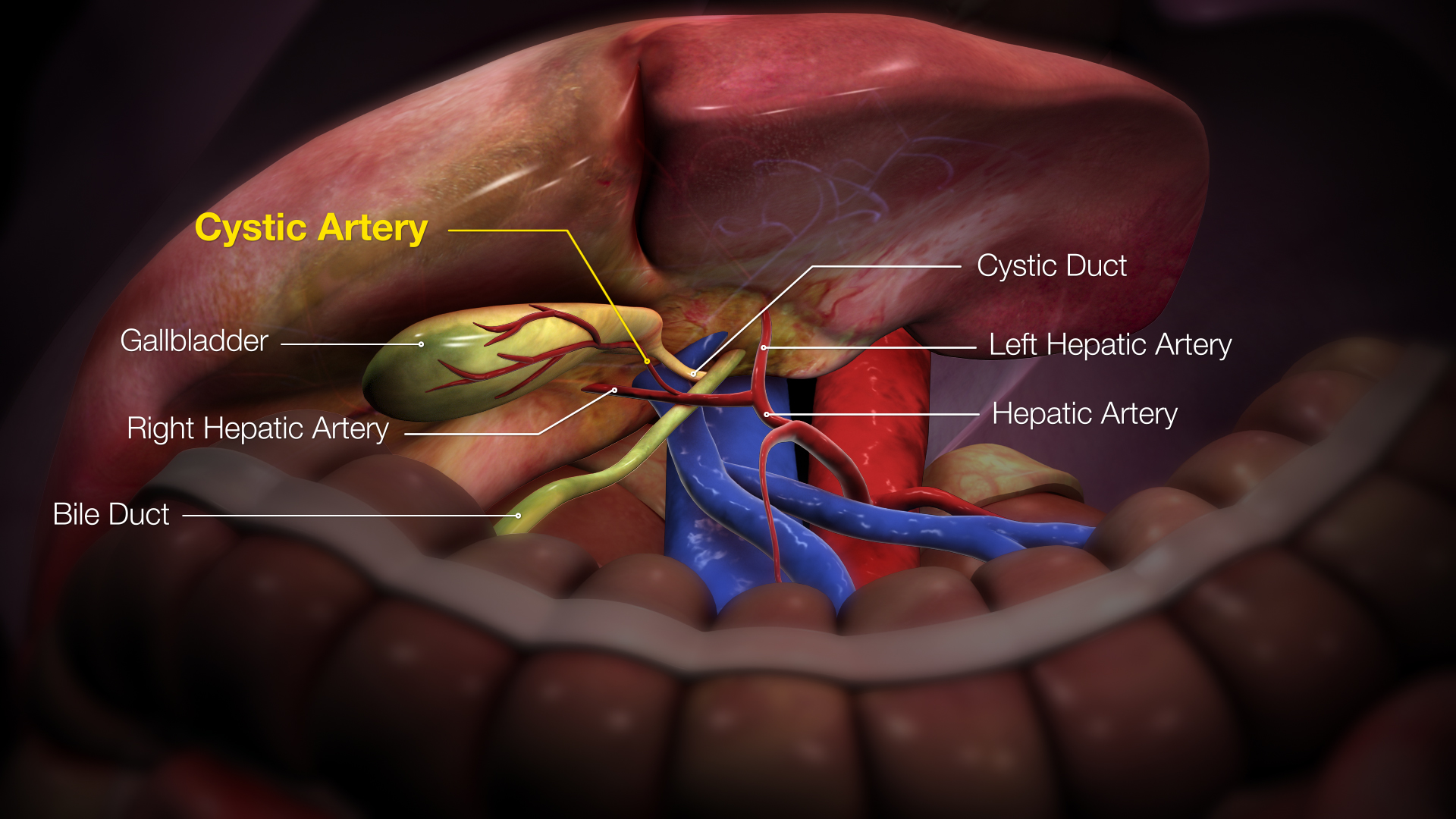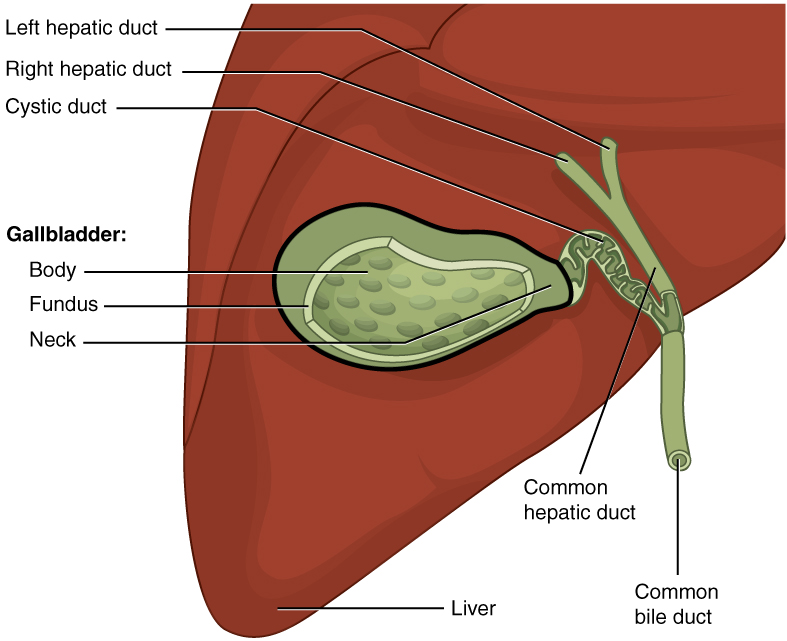|
Cystohepatic Triangle
The cystohepatic triangle (or hepatobiliary triangle) is an anatomic space bordered by the cystic duct inferiorly, the common hepatic duct medially, and the inferior surface of the liver superiorly. The cystic artery lies within the hepatobiliary triangle, which is used to locate it during a laparoscopic cholecystectomy. Structure The hepatobiliary triangle is the area bound by the: * cystic duct inferiorly. * common hepatic duct medially. * inferior margin of the liver superiorly.Schwartz's Manual of Surgery BRUNICARDI C.F 10th edition It is covered in peritoneum both anteriorly and posteriorly. It contains the cystic artery and cystic lymph nodes. The right hepatic artery may also pass through the hepatobiliary triangle. Clinical significance General surgeons frequently quiz medical students on this term and the name for the lymph node located within the triangle, Mascagni's lymph node or Lund's node, however many often erroneously refer to it as "Calot's node". The latter ... [...More Info...] [...Related Items...] OR: [Wikipedia] [Google] [Baidu] |
Right Hepatic Artery
The hepatic artery proper (also proper hepatic artery) is the artery that supplies the liver and gallbladder. It raises from the common hepatic artery, a branch of the celiac artery. Structure The hepatic artery proper arises from the common hepatic artery and runs alongside the portal vein and the common bile duct to form the portal triad. A branch of the common hepatic artery –the gastroduodenal artery gives off the small supraduodenal artery to the duodenal bulb. Then the right gastric artery comes off and runs to the left along the lesser curvature of the stomach to meet the left gastric artery, which is a branch of the celiac trunk. It subsequently bifurcates into the right and left hepatic arteries. Variant anatomy Of note, the right and left hepatic arteries may demonstrate variant anatomy. A misplaced right hepatic artery may arise from the superior mesenteric artery (SMA) and a misplaced left hepatic artery may arise from the left gastric artery. The cystic ar ... [...More Info...] [...Related Items...] OR: [Wikipedia] [Google] [Baidu] |
Anatomic Space
{{set index article In anatomy, a spatium or anatomic space is a space (cavity or gap). Anatomic spaces are often landmarks to find other important structures. When they fill with gases (such as air) or liquids (such as blood) in pathological ways, they can suffer conditions such as pneumothorax, edema, or pericardial effusion. Many anatomic spaces are potential spaces, which means that they are potential rather than realized (with their realization being dynamic according to physiologic or pathophysiologic events). In other words, they are like an empty plastic bag that has not been opened (two walls collapsed against each other; no interior volume until opened) or a balloon that has not been inflated. Examples of anatomic spaces (or potential spaces) include: *Axillary space *Buccal space * Canine space *Cystohepatic triangle * Deep perineal space * Deep temporal space *Epidural space * Extraperitoneal space *Fascial spaces of the head and neck *Infratemporal space *Intercostal s ... [...More Info...] [...Related Items...] OR: [Wikipedia] [Google] [Baidu] |
Cystic Duct
The cystic duct is the short duct that joins the gallbladder to the common hepatic duct. It usually lies next to the cystic artery. It is of variable length. It contains 'spiral valves of Heister', which do not provide much resistance to the flow of bile. Function Bile can flow in both directions between the gallbladder and the common bile duct and the hepatic duct. In this way, bile is stored in the gallbladder in between meal times. The hormone cholecystokinin, when stimulated by a fatty meal, promotes bile secretion by increased production of hepatic bile, contraction of the gall bladder, and relaxation of the Sphincter of Oddi. Clinical significance Gallstones can enter and obstruct the cystic duct, preventing the flow of bile. The increased pressure in the gallbladder leads to swelling and pain. This pain, known as biliary colic, is sometimes referred to as a gallbladder "attack" because of its sudden onset. During a cholecystectomy, the cystic duct is clipped two or ... [...More Info...] [...Related Items...] OR: [Wikipedia] [Google] [Baidu] |
Common Hepatic Duct
The common hepatic duct is the first part of the biliary tract. It joins the cystic duct coming from the gallbladder to form the common bile duct. Structure The common hepatic duct is the first part of the biliary tract. It is formed by the convergence of the right hepatic duct (which drains bile from the right functional lobe of the liver) and the left hepatic duct (which drains bile from the left functional lobe of the liver). It then joins the cystic duct coming from the gallbladder to form the common bile duct. The duct is usually 6–8 cm long. The common hepatic duct is about 6 mm in diameter in adults, with some variation.Gray's Anatomy, 39th ed, p. 1228 The inner surface is covered in a simple columnar epithelium. Variation Around 1.7% of people have additional accessory hepatic ducts that join onto the common hepatic duct. Rarely, the common hepatic duct joins onto the gallbladder directly, leading to illness. Function The hepatic duct is part of the ... [...More Info...] [...Related Items...] OR: [Wikipedia] [Google] [Baidu] |
Liver
The liver is a major Organ (anatomy), organ only found in vertebrates which performs many essential biological functions such as detoxification of the organism, and the Protein biosynthesis, synthesis of proteins and biochemicals necessary for digestion and growth. In humans, it is located in the quadrant (anatomy), right upper quadrant of the abdomen, below the thoracic diaphragm, diaphragm. Its other roles in metabolism include the regulation of Glycogen, glycogen storage, decomposition of red blood cells, and the production of hormones. The liver is an accessory digestive organ that produces bile, an alkaline fluid containing cholesterol and bile acids, which helps the fatty acid degradation, breakdown of fat. The gallbladder, a small pouch that sits just under the liver, stores bile produced by the liver which is later moved to the small intestine to complete digestion. The liver's highly specialized biological tissue, tissue, consisting mostly of hepatocytes, regulates a w ... [...More Info...] [...Related Items...] OR: [Wikipedia] [Google] [Baidu] |
Cystic Artery
The cystic artery (also known as bachelor artery) supplies oxygenated blood to the gallbladder and cystic duct. Most common arrangement In the classic arrangement, occurring with a frequency of approximately 70%, a singular cystic artery originates from the geniculate flexure of the right hepatic artery in the upper portion of the hepatobiliary triangle. A site of origin from a more proximal or distal portion of the right hepatic artery is also considered relatively normal. After separating from the right hepatic artery, the cystic artery travels superiorly to the cystic duct and produces 2 to 4 minor branches, known as ''Calot’s arteries'', that supply part of the cystic duct and cervix of the gallbladder before dividing into the major superficial and deep branches at the superior aspect of the gallbladder neck: * The ''superficial branch'' (or ''anterior branch'') passes subserously over the left aspect of the gallbladder. * The ''deep branch'' (or ''posterior branch'') runs b ... [...More Info...] [...Related Items...] OR: [Wikipedia] [Google] [Baidu] |
Laparoscopy
Laparoscopy () is an operation performed in the abdomen or pelvis using small incisions (usually 0.5–1.5 cm) with the aid of a camera. The laparoscope aids diagnosis or therapeutic interventions with a few small cuts in the abdomen.MedlinePlus > Laparoscopy Update Date: 21 August 2009. Updated by: James Lee, MD // No longer valid Laparoscopic surgery, also called minimally invasive procedure, bandaid surgery, or keyhole surgery, is a modern surgical technique. There are a number of advantages to the patient with laparoscopic surgery versus an exploratory laparotomy. These include reduced pain due to smaller incisions, reduced hemorrhaging, and shorter recovery time. The key element is the use of a laparoscope, a long fiber optic cable system that allows viewing of the affected area by snaking the cable from a more distant, but more easily accessible location. Laparoscopic surgery includes operations within the abdominal or pelvic cavities, whereas keyhole surgery perform ... [...More Info...] [...Related Items...] OR: [Wikipedia] [Google] [Baidu] |
Cholecystectomy
Cholecystectomy is the surgical removal of the gallbladder. Cholecystectomy is a common treatment of symptomatic gallstones and other gallbladder conditions. In 2011, cholecystectomy was the eighth most common operating room procedure performed in hospitals in the United States. Cholecystectomy can be performed either laparoscopically, or via an open surgical technique. The surgery is usually successful in relieving symptoms, but up to 10 percent of people may continue to experience similar symptoms after cholecystectomy, a condition called postcholecystectomy syndrome. Complications of cholecystectomy include bile duct injury, wound infection, bleeding, retained gallstones, abscess formation and stenosis (narrowing) of the bile duct. Medical use Pain and complications caused by gallstones are the most common reasons for removal of the gallbladder. The gallbladder can also be removed in order to treat biliary dyskinesia or gallbladder cancer. Gallstones are very common but ... [...More Info...] [...Related Items...] OR: [Wikipedia] [Google] [Baidu] |
Lymph Node
A lymph node, or lymph gland, is a kidney-shaped organ of the lymphatic system and the adaptive immune system. A large number of lymph nodes are linked throughout the body by the lymphatic vessels. They are major sites of lymphocytes that include B and T cells. Lymph nodes are important for the proper functioning of the immune system, acting as filters for foreign particles including cancer cells, but have no detoxification function. In the lymphatic system a lymph node is a secondary lymphoid organ. A lymph node is enclosed in a fibrous capsule and is made up of an outer cortex and an inner medulla. Lymph nodes become inflamed or enlarged in various diseases, which may range from trivial throat infections to life-threatening cancers. The condition of lymph nodes is very important in cancer staging, which decides the treatment to be used and determines the prognosis. Lymphadenopathy refers to glands that are enlarged or swollen. When inflamed or enlarged, lymph nodes can be ... [...More Info...] [...Related Items...] OR: [Wikipedia] [Google] [Baidu] |
Lund's Node
Lund's node, or Mascagni's lymph node (often erroneously referred to as Calot's node), is the sentinel lymph node of the gall bladder. It increases in size in cholecystitis and cholangitis. It is an anatomic landmark and is removed along with the gall bladder in cholecystectomy. It is situated within the Triangle of Calot, where abides the space below the cystic artery. The node is named after Fred Bates Lund (1865-1950), an American surgeon. It was also named after the Italian anatomist and physician, Paolo Mascagni Paolo Mascagni (25 January 1755 – 19 October 1815) was an Italian physician and anatomist. He is most well known for publishing the first complete description of the lymphatic system. Biography Early life Mascagni was born in the co ... (1752-1815), who first identified the node around 1787. Lymphatics of the torso Anatomic Landmarks References {{lymphatic-stub ... [...More Info...] [...Related Items...] OR: [Wikipedia] [Google] [Baidu] |
Cholecystitis
Cholecystitis is inflammation of the gallbladder. Symptoms include right upper abdominal pain, pain in the right shoulder, nausea, vomiting, and occasionally fever. Often gallbladder attacks (biliary colic) precede acute cholecystitis. The pain lasts longer in cholecystitis than in a typical gallbladder attack. Without appropriate treatment, recurrent episodes of cholecystitis are common. Complications of acute cholecystitis include gallstone pancreatitis, common bile duct stones, or inflammation of the common bile duct. More than 90% of the time acute cholecystitis is caused from blockage of the cystic duct by a gallstone. Risk factors for gallstones include birth control pills, pregnancy, a family history of gallstones, obesity, diabetes, liver disease, or rapid weight loss. Occasionally, acute cholecystitis occurs as a result of vasculitis or chemotherapy, or during recovery from major trauma or burns. Cholecystitis is suspected based on symptoms and laboratory testing. Abdom ... [...More Info...] [...Related Items...] OR: [Wikipedia] [Google] [Baidu] |




.jpg)
